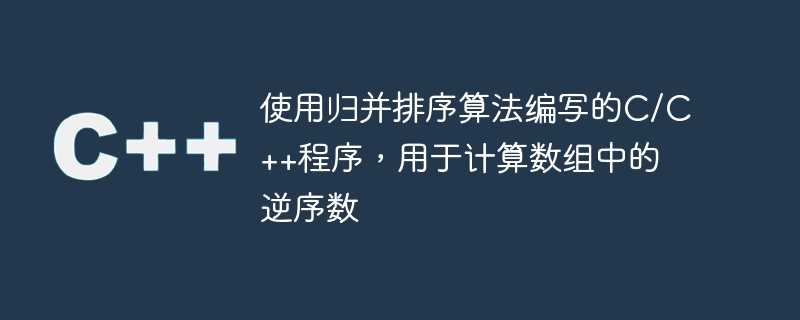

La représentation inversée d'un tableau ; combien de modifications sont nécessaires pour convertir le tableau dans sa forme triée. Lorsque le tableau est déjà trié, 0 inversion est nécessaire, tandis que dans les autres cas, si le tableau est inversé, le nombre maximum d'inversions est atteint.
Pour résoudre ce problème, nous suivrons la méthode de tri par fusion pour réduire la complexité temporelle et utiliserons l'algorithme diviser pour régner.
A sequence of numbers. (1, 5, 6, 4, 20).
Le nombre d'inversions nécessaires pour trier les nombres par ordre croissant.
Here the number of inversions are 2. First inversion: (1, 5, 4, 6, 20) Second inversion: (1, 4, 5, 6, 20)
Input - deux tableaux qui ont été fusionnés, index gauche, droit et central.
Output - tableaux fusionnés dans l'ordre trié.
Begin
i := left, j := mid, k := right
count := 0
while i <= mid -1 and j <= right, do
if array[i] <= array[j], then
tempArray[k] := array[i]
increase i and k by 1
else
tempArray[k] := array[j]
increase j and k by 1
count := count + (mid - i)
done
while left part of the array has some extra element, do
tempArray[k] := array[i]
increase i and k by 1
done
while right part of the array has some extra element, do
tempArray[k] := array[j]
increase j and k by 1
done
return count
EndInput - Étant donné un tableau et un tableau temporaire, les indices gauche et droit du tableau.
Sortie - Le nombre de paires inversées après le tri.
Begin
count := 0
if right > left, then
mid := (right + left)/2
count := mergeSort(array, tempArray, left, mid)
count := count + mergeSort(array, tempArray, mid+1, right)
count := count + merge(array, tempArray, left, mid+1, right)
return count
EndDémonstration en temps réel
#include <iostream>
using namespace std;
int merge(int arr[], int temp[], int left, int mid, int right) {
int i, j, k;
int count = 0;
i = left; //i to locate first array location
j = mid; //i to locate second array location
k = left; //i to locate merged array location
while ((i <= mid - 1) && (j <= right)) {
if (arr[i] <= arr[j]){ //when left item is less than right item
temp[k++] = arr[i++];
} else {
temp[k++] = arr[j++];
count += (mid - i); //find how many convertion is performed
}
}
while (i <= mid - 1) //if first list has remaining item, add them in the list
temp[k++] = arr[i++];
while (j <= right) //if second list has remaining item, add them in the list
temp[k++] = arr[j++];
for (i=left; i <= right; i++)
arr[i] = temp[i]; //store temp Array to main array
return count;
}
int mergeSort(int arr[], int temp[], int left, int right){
int mid, count = 0;
if (right > left) {
mid = (right + left)/2; //find mid index of the array
count = mergeSort(arr, temp, left, mid); //merge sort left sub array
count += mergeSort(arr, temp, mid+1, right); //merge sort right sub array
count += merge(arr, temp, left, mid+1, right); //merge two sub arrays
}
return count;
}
int arrInversion(int arr[], int n) {
int temp[n];
return mergeSort(arr, temp, 0, n - 1);
}
int main() {
int arr[] = {1, 5, 6, 4, 20};
int n = 5;
cout << "Number of inversions are "<< arrInversion(arr, n);
}Number of inversions are 2
Ce qui précède est le contenu détaillé de. pour plus d'informations, suivez d'autres articles connexes sur le site Web de PHP en chinois!
 Introduction à l'utilisation de la fonction sort() en python
Introduction à l'utilisation de la fonction sort() en python
 Qu'est-ce qu'un plug-in de navigateur
Qu'est-ce qu'un plug-in de navigateur
 Pilote de carte son pour ordinateur portable
Pilote de carte son pour ordinateur portable
 Comment changer le mot de passe dans MySQL
Comment changer le mot de passe dans MySQL
 Quelles sont les solutions de stockage Big Data ?
Quelles sont les solutions de stockage Big Data ?
 Comment télécharger et enregistrer les vidéos phares du jour
Comment télécharger et enregistrer les vidéos phares du jour
 Comment utiliser la fonction mois
Comment utiliser la fonction mois
 Nettoyer les fichiers indésirables dans Win10
Nettoyer les fichiers indésirables dans Win10
 orientéb
orientéb